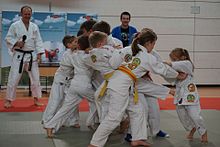Stenka (martial arts)
Stenka (Russian) is an ancient Russian martial art. The word stands for wall, wall. The expression is shaped by the fighting style, as the fighters in the team meet as a wall.
origin
In its form, Stenka is a unique martial arts and self-defense system that is native to Russia . Stenka's roots go back well over 1000 years and can just be found in old Russian drawings, sketches and paintings. Stenka is also known in Central Europe. The native Russian popular sport lived on into modern times, but was banned in 1917 after the revolution.
It was only in the 21st century that this old martial art was brought back to life and since then it has been continuously developed and spread. Stenka is currently being developed in parallel in 18 countries; the headquarters of the International Stenka Federation are in Lausanne ( Switzerland ).
The main characteristic of Stenka, and at the same time the difference to other martial arts, is that it is fought in a team. Each team must always focus on the current situation and on its weakest member in order not to lose the fight. There is an uninterrupted interaction between the team fighters during training and during the fight. Whether a team loses or wins is not decided based on the performance of an individual fighter, but solely on the overall performance and actions of the team.
competition
Two teams appear in a narrow row (stenka = wall) opposite one another. The teams usually consist of at least 2 fighters, depending on the spatial conditions, teams with 20 or more participants per team can be formed. In the basic position, the participants of a team get caught on a narrow wall. The first tactic already plays a role here, where which team members are integrated in the emerging chain.
In the basic step the left foot is put forward, the left hand defends your own face. Attacks can be made with the right hand.
After a start signal, both rows move towards each other. Similar to the martial arts Judo / Ju-Jutsu , there are clear rules for points:
the fight round is considered lost:
- when one's own chain has been broken.
- when a team member hits the ground with his knees or hands, or falls over completely.
- when a team member is forced out of the ring and one foot leaves the ring.
Associations
- Stenka International Martial Arts Federation based in Lausanne (Switzerland)
distribution
As of 2017, Stenka is used in the following countries:
- Russia (also as school sport)
- Japan (also as a school sport)
- Kazakhstan
- Kyrgyzstan
- Tajikistan
- Estonia
- Latvia
- Azerbaijan
- Slovakia
- France
- Switzerland
- Germany
Current story
On October 30, 2016 the first world championship took place in the Stenka in Moscow. Stenka Bayern and the German Stenka Bund e. V. were founded in 2017.
Individual evidence
- ↑ Л.Ю. ЛАГУТКИНА, С.В. ПОНОМАРЁВ: ОРГАНИЧЕСКАЯ АКВАКУЛЬТУРА КАК ПЕРСПЕКТИВНОЕ НАПРАВЛЕНИЕ РАЗВИТИЯ РЫБОХОЗЯЙСТЕНОЙ ОТ . In: Sel'skokhozyaistvennaya Biologiya . tape 53 , no. 2 , February 2018, ISSN 0131-6397 , p. 326–336 , doi : 10.15389 / agrobiology.2018.2.326rus (dx.doi.org/10.15389/agrobiology.2018.2.326rus [accessed January 16, 2020]).
- ↑ The Stenka Martial Art and Sport - World Stenka Championship 2016. Retrieved January 16, 2020 (American English).
- ↑ Picture by Dmitri Alexandrowitsch Rowinski http://www.spbring.ru/images1/book05.jpg
- ↑ La technique du Stenka. Retrieved May 15, 2017 .
- ↑ L'art martial corps a corps russe. Retrieved May 15, 2017 .
- ↑ https://www.facebook.com/profile.php?id=100009827837668
- ↑ https://www.facebook.com/stenka.japan/
- ↑ https://www.facebook.com/stenka.kyrgystan
- ↑ STENKA - Le STENKA, l'art martial russian. Retrieved May 15, 2017 (French).
- ↑ Stenka Suisse
- ↑ https://www.facebook.com/stenka.switzerland/
- ↑ https://www.facebook.com/stenkaGermany
- ↑ https://www.facebook.com/StenkaBayern
- ↑ Harald Bäs-Fischlmair: Deutscher Stenka Bund e. V. Accessed on May 15, 2017 (German).


